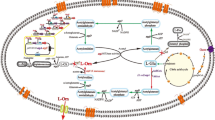Summary
This report describes the enzyme-catalyzed synthesis, characterization, and chromatographic separation of N6-(carboxymethyl)-L-lysine and N5-(carboxymethyl)-L-ornithine. The two Nω-(carboxyalkyl)amino acids are formed via a reductive condensation between glyoxylate and theε- orδ-amino groups of lysine and ornithine, respectively. Both reactions are catalyzed by the NADPH-dependent enzyme, N5-(carboxyethyl)ornithine synthase [EC 1.5.1.24], found in some strains of the lactic acid bacteriumLactococcus lactis subsp.lactis.
Similar content being viewed by others
References
Ahmed MU, Thorpe SR, Baynes JW (1986) Identification of Nε-carboxymethyl-lysine as a degradation product of fructoselysine in glycated protein. J Biol Chem 261: 4889–4894
Ahmed MU, Dunn JA, Walla MD, Thorpe SR, Baynes JW (1988) Oxidative degradation of glucose adducts to protein. Formation of 3-(Nε-lysine)-lactic acid from model compounds and glycated proteins. J Biol Chem 263: 8816–8821
Anderson ME, Meister A (1986) Inhibition ofγ-glutamyl transpeptidase and induction of glutathionuria byγ-glutamyl amino acids. Proc Natl Acad Sci USA 83: 5029–5032
Baynes JW (1991) Perspectives in diabetes. Role of oxidative stress in development of complications in diabetes. Diabetes 40: 405–412
Büser W, Erbersdobler HF, Liardon R (1987) Identification and determination of N-ε-carboxymethyl lysine by gas-liquid chromatography. J Chromatogr 387: 515–519
Chin CCQ, Wold F (1975) Some chemical properties of carboxymethyl derivatives of amino acids. Arch Biochem Biophys 167: 448–451
Donkersloot JA, Thompson J (1990) Simultaneous loss of N5-(carboxyethyl)ornithine synthase, nisin production, and sucrose-fermenting ability byLactococcus lactis K1. J Bacteriol 172: 4122–4126
Dunn JA, McCance DR, Thorpe SR, Lyons TJ, Baynes JW (1991) Age-dependent accumulation of Nε-(carboxymethyl)lysine and Nε-(carboxymethyl)hydroxylysine in human skin collagen. Biochemistry 30: 1205–1210
Dyer DG, Blackledge JA, Thorpe SR, Baynes JW (1991) Formation of pentosidine during nonenzymatic browning of proteins by glucose. Identification of glucose and other carbohydrates as possible precursors of pentosidinein vivo. J Biol Chem 266: 11654–11660
Gäde G, Grieshaber MK (1986) Pyruvate reductases catalyze the formation of lactate and opines in anaerobic invertebrates. Comp Biochem Physiol B 83: 255–272
Gould BJ, Walsh DP, Ah-Sing E, Wright J, Stace BC (1989) Urinary carboxymethyl-lysine measurement as a potential indicator of diabetic complications. Biochem Soc Trans 17: 1087–1088
Griffith OW, Meister A (1977) Selective inhibition ofγ-glutamyl-cycle enzymes by substrate analogs. Proc Natl Acad Sci USA 74: 3330–3334
Gundlach HG, Stein WH, Moore S (1959) The nature of the amino acid residues involved in the inactivation of ribonuclease by iodoacetate. J Biol Chem 234: 1754–1760
Kobes RD, Dekker EE (1971) 2-Keto-4-hydroxyglutarate aldolase of bovine liver. Schiffbase formation with 2-keto-4-hydroxyglutarate, pyruvate and glyoxylate. Biochemistry 10: 388–395
Krook M, Ghosh D, Strömberg R, Carlquist M, Jörnvall H (1993) Carboxyethyllysine in a protein: native carbonyl reductase/NADP+-dependent prostaglandin dehydrogenase. Proc Natl Acad Sci USA 90: 502–506
Liardon R, de Weck-Gaudard D, Phillippossian G, Finot P-A (1987) Identification of Nε-carboxymethyllysine: a new Maillard reaction product, in rat urine. J Agric Food Chem 35: 427–431
Matsutani H, Kusumoto S, Koizumi R, Shiba T (1979) Nε-(Carboxymethyl)-L-lysine in the acid hydrolysate ofSagittaria pygmaea. Phytochem 18: 661–662
Miller SPF, Thompson J (1987) Biosynthesis and stereochemical configuration of N5(1-carboxyethyl)ornithine. An unusual amino acid produced byStreptococcus lactis. J Biol Chem 262: 16109–16115
Miyazawa T (1980) Studies of unusual amino acids and their peptides. XII. The chemistry of N-(carboxymethyl)amino acids. I. The preparation, properties and characterization of N-(carboxymethyl)amino acids and their esters. Bull Chem Soc Jpn 53: 2555–2565
Tabor S, Richardson CC (1985) A bacteriophage T7 RNA polymerase/promoter system for controlled exclusive expression of specific genes. Proc Natl Acad Sci USA 82: 1074–1078
Taniguchi N, Meister A (1978)γ-Glutamyl cyclotransferase from rat kidney. Sulfhydryl groups and isolation of a stable form of the enzyme. J Biol Chem 253: 1799–1806
Tempé J (1983) Chemistry and biochemistry of open-chain imino acids. In: Weinstein B (ed) Chemistry and biochemistry of amino acids, peptides, and proteins. Marcel Dekker, New York, pp 113–203
Tempé J, Goldmann A (1982) Occurrence and biosynthesis of opines. In: Kahl G, Schell JS (eds) Molecular biology of plant tumors. Academic Press, Orlando, pp 427–449
Thompson J (1989) N5-(L-1-Carboxyethyl)-L-ornithine: NADP+ oxidoreductase fromStreptococcus lactis. Purification and partial characterization. J Biol Chem 264: 9592–9601
Thompson J, Donkersloot JA (1992) N-(Carboxyalkyl)amino acids: occurrence, synthesis, and functions. Ann Rev Biochem 61: 517–557
Thompson J, Miller SPF (1988) N6-(1-Carboxyethyl)lysine formation byStreptococcus lactis. Purification, synthesis, and stereochemical structure. J Biol Chem 263: 2064–2069
Thompson J, Miller SPF (1991) N5-(1-Carboxyethyl)ornithine and related [N-carboxyalkyl]-amino acids: structure, biosynthesis, and function. Adv Enzymol 64: 317–399
Thompson J, Curtis MA, Miller SPF (1986) N5-(1-Carboxyethyl)-ornithine, a new amino acid from the intracellular pool ofStreptococcus lactis. J Bacteriol 167: 522–529
Thompson J, Harr RJ, Donkersloot JA (1990) N5-(L-1-Carboxyethyl)-L-ornithine: NADP+ oxidoreductase inStreptococcus lactis: distribution, constitutivity, and regulation. Curr Microbiol 20: 239–244
Thompson J, Nguyen NY, Sackett DL, Donkersloot JA (1991) Transposon-encoded sucrose metabolism inLactococcus lactis. Purification of sucrose-6-phosphate hydrolase and genetic linkage to N5-(L-1-carboxyethyl)-L-ornithine synthase in strain K1. J Biol Chem 266: 14573–14579
Vlahos CJ, Dekker EE (1986) Amino acid sequence of the pyruvate and the glyoxylate active-site lysine peptide ofEscherichia coli 2-keto-4-hydroxyglutarate aldolase. J Biol Chem 261: 11049–11055
Wadman SK, De Bree PK, Van Sprang FJ, Kamerling JP, Haverkamp J, Vliegenthart JFG (1975) Nε-(Carboxymethyl)lysine, a constituent of human urine. Clin Chim Acta 59: 313–320
Author information
Authors and Affiliations
Rights and permissions
About this article
Cite this article
Miller, S.P.F., Donkersloot, J.A. & Thompson, J. Enzymatic synthesis and characterization of N5-(carboxymethyl)-L-ornithine and N6-(carboxymethyl)-L-lysine. Amino Acids 6, 189–198 (1994). https://doi.org/10.1007/BF00805846
Received:
Accepted:
Issue Date:
DOI: https://doi.org/10.1007/BF00805846




